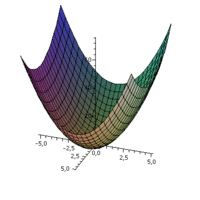M2-VO-Prüfung Gittenberger
(8 Pkt.) Lösen Sie ∫ 6 − 2 x ( x − 1 ) ( x − 2 ) d x {\displaystyle \int {\frac {6-2x}{(x-1)(x-2)}}dx}
(8 Pkt.) Ermitteln Sie mithilfe von Lagrange-Multiplikatoren die stationären Punkte von f ( x , y ) = x 2 + 2 y 2 {\displaystyle f(x,y)=x^{2}+2y^{2}} x + y = 3 {\displaystyle x+y=3}
(8 Pkt.) a n = 8 a n − 1 + 16 a n − 2 = 2 n − 1 {\displaystyle a_{n}=8a_{n-1}+16a_{n-2}=2^{n-1}} a 0 = 2 , a 1 = 3 {\displaystyle a_{0}=2,\;a_{1}=3}
(8 Pkt.) Erklären Sie: Kurve in R 3 {\displaystyle \mathbb {R} ^{3}} Vektorfeld im R 3 {\displaystyle \mathbb {R} ^{3}} Kurvenintegral entlang dieser Kurve, weg-unabhängigkeit , was ist eine hinreichende Bedingung für Wegunabhängigkeit?
(8 Pkt.) Erklären Sie: lineare Differentialgleichung 1. Ordnung , was ist die Lösungsgesamtheit einer inhomogenen DiffGl 1.O , erklären Sie das Verfahren zur Berechnung derselben und geben Sie ein Beispiel ! (Diese Prüfung wird momentan als Musterprüfung geführt).
∫ 6 − 2 x ( x − 1 ) ( x − 2 ) d x {\displaystyle \int {\frac {6-2x}{(x-1)(x-2)}}dx}
Partialbruchzerlegung:
6 − 2 x ( x − 1 ) ( x − 2 ) = A x − 1 + B x − 2 {\displaystyle {\frac {6-2x}{(x-1)(x-2)}}={\frac {A}{x-1}}+{\frac {B}{x-2}}}
6 − 2 x = A x − 2 A + B x − B {\displaystyle 6-2x=A~x-2A+B~x-B}
Koeffizientenvergleich:
− 2 = A + B ⇒ B = − 2 − A {\displaystyle -2=A+B\Rightarrow B=-2-A}
6 = − 2 A − B = − A + 2 {\displaystyle 6=-2A-B=-A+2}
A = − 4 {\displaystyle A=-4}
B = 2 {\displaystyle B=2}
Integrieren:
− 4 ∫ 1 x − 1 d x + 2 ∫ 1 x − 2 d x = − 4 ln | x − 1 | + 2 ln | x − 2 | + C {\displaystyle -4\int {\frac {1}{x-1}}dx+2\int {\frac {1}{x-2}}dx=-4\ln |x-1|+2\ln |x-2|+C}
Beispiel 2: f(x,y)=x²+2y² f ( x , y ) = x 2 + 2 y 2 {\displaystyle f(x,y)=x^{2}+2y^{2}}
N B : x + y = 3 {\displaystyle NB:x+y=3}
x + y − 3 = 0 {\displaystyle x+y-3=0}
danach bringt man die Funktion auf die Form
Φ ( x , y ) = x 2 + 2 y 2 + λ ∗ ( x + y − 3 ) {\displaystyle \Phi (x,y)=x^{2}+2y^{2}+\lambda *(x+y-3)}
Φ x , Φ y , Φ λ {\displaystyle \Phi _{x},\Phi _{y},\Phi _{\lambda }}
Φ x = 2 x + λ = 0 {\displaystyle \Phi _{x}=2x+\lambda =0}
Φ y = 4 y + λ = 0 {\displaystyle \Phi _{y}=4y+\lambda =0}
Φ λ = x + y − 3 = 0 {\displaystyle \Phi _{\lambda }=x+y-3=0}
x , y , λ {\displaystyle x,y,\lambda }
Da erhält man dann den Punkt P(2,1)
Mögliche Vorgehensweise:
Φ x − Φ y = 2 x − 4 y = 0 {\displaystyle \Phi _{x}-\Phi _{y}=2x-4y=0}
Φ λ {\displaystyle \Phi _{\lambda }} → y = 3 − x {\displaystyle \rightarrow y=3-x}
einsetzen:
2 x − 4 ( 3 − x ) = 0 → x = 2 {\displaystyle 2x-4(3-x)=0\rightarrow x=2}
y = 3 − 2 = 1 {\displaystyle y=3-2=1}
a n = 8 a n − 1 − 16 a n − 2 + 2 ( n − 1 ) {\displaystyle a_{n}=8a_{n-1}-16a_{n-2}+2^{(n-1)}}
a 0 = 2 {\displaystyle a_{0}=2}
a 1 = 3 {\displaystyle a_{1}=3}
a n − 8 a n − 1 + 16 a n − 2 = 2 ( n − 1 ) {\displaystyle a_{n}-8a_{n-1}+16a_{n-2}=2^{(n-1)}}
Ansatz für die homogene Lösung :
λ 2 − 8 λ + 16 = 0 {\displaystyle \lambda ^{2}-8\lambda +16=0}
λ 1 , 2 = 4 ± 4 2 − 16 = 4 {\displaystyle \lambda _{1,2}=4\pm {\sqrt {4^{2}-16}}=4}
deshalb ist die homogene Lösung
a n ( h ) = ( C 1 + C 2 n ) λ 1 n = ( C 1 + C 2 n ) 4 n {\displaystyle a_{n}^{(h)}=(C_{1}+C_{2}n)\lambda _{1}^{n}=(C_{1}+C_{2}n)4^{n}}
Nun zur partikulären Lösung :
S ( n ) = 2 n − 1 = 1 2 2 n {\displaystyle S(n)=2^{n-1}={\frac {1}{2}}2^{n}}
dadurch ergibt sich der Ansatz
a n ( p ) = A ∗ 2 n {\displaystyle a_{n}^{(p)}=A*2^{n}}
Diesen setzt man nun in die Gleichung ein.
A ∗ 2 n − 8 A ∗ 2 n − 1 + 16 A ∗ 2 n − 2 = 2 n − 1 {\displaystyle A*2^{n}-8A*2^{n-1}+16A*2^{n-2}=2^{n-1}}
nun durch 2 n − 1 {\displaystyle 2^{n-1}}
2 A − 8 A + 8 A = 1 {\displaystyle 2A-8A+8A=1}
A = 1 2 {\displaystyle A={\frac {1}{2}}}
Nun haben wir die partikuläre Lösung mit
a n ( p ) = 1 2 ∗ 2 n {\displaystyle a_{n}^{(p)}={\frac {1}{2}}*2^{n}}
a n = ( C 1 + C 2 n ) 4 n + 1 2 ∗ 2 n {\displaystyle a_{n}=(C_{1}+C_{2}n)4^{n}+{\frac {1}{2}}*2^{n}}
Da wir auch 2 spezielle Lösungen vorgegeben haben, müssen wir uns mit diesen noch C 1 , C 2 {\displaystyle C_{1},C_{2}}
( I ) a 0 : 2 = ( C 1 + C 2 ∗ 0 ) 4 0 + 1 2 ∗ 2 0 = C 1 + 1 2 {\displaystyle (I)a_{0}:2=(C_{1}+C_{2}*0)4^{0}+{\frac {1}{2}}*2^{0}=C_{1}+{\frac {1}{2}}}
( I I ) a 1 : 3 = ( C 1 + C 2 ∗ 1 ) 4 1 + 1 2 ∗ 2 1 = 4 ∗ C 1 + 4 ∗ C 2 + 1 1 2 {\displaystyle (II)a_{1}:3=(C_{1}+C_{2}*1)4^{1}+{\frac {1}{2}}*2^{1}=4*C_{1}+4*C_{2}+1{\frac {1}{2}}}
aus ( I ) {\displaystyle (I)} C 1 = 3 2 {\displaystyle C_{1}={\frac {3}{2}}}
aus ( I I ) + ( I ) {\displaystyle (II)+(I)} C 2 = − 1 {\displaystyle C_{2}=-1}
a n = ( 3 2 − n ) 4 n + 1 2 ∗ 2 n {\displaystyle a_{n}=({\frac {3}{2}}-n)4^{n}+{\frac {1}{2}}*2^{n}}
Wikipädia:
